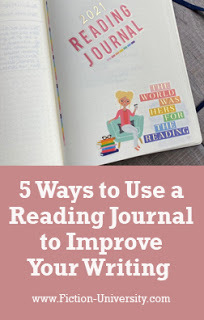Janice Hardy's Blog, page 25
April 10, 2021
WIP Diagnostic: Is This Working? A Closer Look at Balancing World Building and Hooks
 Critique by Janice Hardy, @Janice_Hardy
Critique by Janice Hardy, @Janice_Hardy WIP Diagnostics is a weekly column that studies a snippet of a work in progress for specific issues. Readers are encouraged to send in work with questions, and we diagnose it on the site. It’s part critique, part example, and designed to help the submitter as well as anyone else having a similar problem.
If you're interested in submitting to WIP Diagnostics, please check out these guidelines.
Submissions currently in the queue: Two
Please Note: As of today, critique slots are booked through April 24.
This week’s question:
1. Does this opening give enough information to hook the reader? In other words, would you keep reading?
Market/Genre: Science Fantasy
On to the diagnosis…
Continue ReadingWritten by Janice Hardy. Fiction-University.com
Published on April 10, 2021 04:38
April 8, 2021
3 Powerful Ways Pros Create Character Conflict
 By Laurence MacNaughton, @LMacNaughton
By Laurence MacNaughton, @LMacNaughtonPart of The How They Do It Series
JH: Conflict is a lot more than arguing. Laurence MacNaughton shares three ways you can create conflict that matters to the story.
Have you ever written a scene where two characters argue, but it just seems to fall flat? Have you ever felt like a dialogue scene never sizzles, no matter how much conflict you pump into it?
Your story might have a bad case of character bickering. By that I mean that the characters are arguing, maybe insulting one another, but the conflict doesn't really show who they are as people.
Bickering feels bratty and shallow. True character conflict feels much deeper and more gripping.
If you suspect that your characters might be bickering, don't worry. The bad news is that it will take a little bit of digging and brainstorming to fix the problem. The good news is that there is a solution. Three of them, in fact.
Continue ReadingWritten by Janice Hardy. Fiction-University.com
Published on April 08, 2021 03:00
April 6, 2021
5 Ways to Use Holidays in Your Story
 By Bethany Henry
By Bethany HenryPart of The How They Do It Series
JH: Celebrations can be delightful backdrops for a novel. Bethany Henry shares tips on how to enrich your story with a holiday.
Bethany Henry writes fantasy novels and blogs about writing and wellness at bethany-henry.com. When not writing, she can often be found on the frisbee field, drinking tea, or reading picture books with her two little girls. Sign up for her email list for weekly posts on writing craft- along with fun extras like quotes and freebies.
Website | Blog | Facebook | Pinterest | Email List
Take it away Bethany...Continue ReadingWritten by Janice Hardy. Fiction-University.com
Published on April 06, 2021 03:27
April 5, 2021
6 Problems Your Query Letter Reveals About Your Novel
 By Janice Hardy, @Janice_Hardy
By Janice Hardy, @Janice_Hardy How much can you really tell about a novel from its query? A lot, actually.
It's the rare writer who actually enjoys writing a query (I'm one of those now, but that wasn't always the case). Say the word query around a group of writers and you'll most likely hear groans. Odds are, someone in that group will ask, "Why do we need to do this? It's not like an agent can tell anything about the book from two paragraphs anyway."
Would it surprise you to hear you can tell a lot about a book from the query letter?
As a writer, I've critiqued more queries and novels than I can count, and I don't even come close to the number agents and editors see every month, if not every week. But I can tell what problems I'm likely to find in a manuscript after reading just the query letter.
Continue ReadingWritten by Janice Hardy. Fiction-University.com
Published on April 05, 2021 03:00
April 3, 2021
WIP Diagnostic: Is This Working? A Closer Look at Authorial Intrusion and Humor
 Critique by Janice Hardy, @Janice_Hardy
Critique by Janice Hardy, @Janice_Hardy WIP Diagnostics is a weekly column that studies a snippet of a work in progress for specific issues. Readers are encouraged to send in work with questions, and we diagnose it on the site. It’s part critique, part example, and designed to help the submitter as well as anyone else having a similar problem.
If you're interested in submitting to WIP Diagnostics, please check out these guidelines.
Submissions currently in the queue: Three
Please Note: As of today, critique slots are booked through April 24.
This week’s question:
1. I'm hoping authorial intrusion right off the bat will help set a humorous tone. Unfortunately, that delays dialogue till the next page, which may be a bit late. Do you judge the authorial intrusion could allow the delayed introduction of dialogue?
Market/Genre: Adult Action Adventure
On to the diagnosis…
Continue ReadingWritten by Janice Hardy. Fiction-University.com
Published on April 03, 2021 04:51
April 2, 2021
Story Structure: How The Climax Works in a Novel
 By Janice Hardy, @Janice_Hardy
By Janice Hardy, @Janice_Hardy The climax resolves the plot problem and makes readers glad they picked up the novel.
There’s a popular series* with a climax that made me so furious I stopped reading that author. Until that moment, I’d devoured all eight books, loved them, and in that last 10% of the final book, the author had the protagonist make a decision that invalidated the entire series and made me go from “Yes, I want you to win!” to “You don’t deserve the victory what the heck were you thinking???”
I was livid. I had to stop reading and call my niece (we were reading the series together) and we hashed out how awful this ridiculous decision was. I gritted my teeth and dived back in to finish it, and then watched in horror as the story I’d loved dissolved into a pointless, deus ex machina ending.
This is not the climax you want for your novel.
Continue ReadingWritten by Janice Hardy. Fiction-University.com
Published on April 02, 2021 05:02
April 1, 2021
5 Ways to Layer Depth into Your Story
 By Jodi Turchin, @jlturchin
By Jodi Turchin, @jlturchinPart of The How They Do It Series
JH: Just because you write all the dialogue first doesn't mean you can't craft a layered story. Jodi Turchin shares tips on adding the depth after your first draft is done.
Jodi Turchin is a Young Adult novelist represented by Dawn Frederick at Red Sofa Literary. She’s also a photographer, a high school English teacher, an adjunct college professor, and a former actress and director.
Website | Twitter
Take it away Jodi…
Continue ReadingWritten by Janice Hardy. Fiction-University.com
Published on April 01, 2021 03:00
March 31, 2021
So, I’m Cutting Back on Blogging a Bit
 By Janice Hardy, @Janice_Hardy
By Janice Hardy, @Janice_Hardy Sometimes, the right thing to do is to stop what you’re doing—even if you love doing it.
For a long time now, I’ve been burned out on blogging. I’ve kept it up because I do enjoy it, and I love helping writers, but it’s all gotten to be a bit too much to keep up with.
I started this blog back in March of 2008. I’ve written anywhere from three to seven posts a week for the past 13 years—and regular readers know I rarely write short posts (grin). There are over 3,000 articles on the site now, and I estimate I’ve written a good 2,000 of them. That’s about 3,000,000 words. Yes, you read that right—millions of words. For the math curious, that’s 37 80,000-word novels.
After so many words and so many years, it’s hard to come up with new things to write about that I haven’t done several times before. I’ve been updating old posts for a while now, but sometimes they take longer to edit than the new posts.Continue ReadingWritten by Janice Hardy. Fiction-University.com
Published on March 31, 2021 03:30
March 30, 2021
5 Ways to Use a Reading Journal to Improve Your Writing
 By Roni Loren, @RoniLoren
By Roni Loren, @RoniLoren Part of The Writer's Life Series
JH: I’ve always been a fan of studying novels you enjoyed to see how the authors did it. Roni Loren has taken it to a whole new level with a reading journal.
Roni wrote her first romance novel at age fifteen when she discovered writing about boys was way easier than actually talking to them. Since then, her flirting skills haven’t improved, but she likes to think her storytelling ability has. She holds a master’s degree in social work and spent years as a mental health counselor, but now she writes full time from her cozy office in Dallas, Texas where she puts her characters on the therapy couch instead. She is a two-time RITA Award winner and a New York Times and USA Today bestselling author. She also teaches online writing classes at her Fearless Romance Writing Academy.
Website | Newsletter | Facebook | Instagram | Twitter
Take it away Roni…
Continue ReadingWritten by Janice Hardy. Fiction-University.com
Published on March 30, 2021 03:00
March 29, 2021
4 Ways to Create Emotional Peril in Your Characters
 By Janice Hardy, @Janice_Hardy
By Janice Hardy, @Janice_Hardy If you can’t get readers to emotionally connect with your novel, they won’t read your novel.
When you pick up a novel, what keeps you reading?
The desire to see what happens next? The fear that something horrible will happen to your favorite character? The need to see it all turn out for the best? The need to know what happens next or what it all means? Maybe all of these at different times in the book.
No matter what hooks a reader about a book, they’ve made an emotional connection with it. They care, and don't want to see the characters get hurt. But the wonderful thing is, once you've made that emotional connection, "hurt" takes on a much broader definition.
Continue ReadingWritten by Janice Hardy. Fiction-University.com
Published on March 29, 2021 04:26



